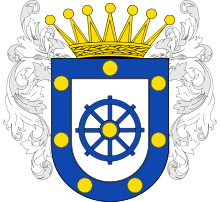|
Ludwig Knoop
Baron Johann Ludwig von Knoop (15 May 1821, in Bremen – 14 August 1894, in Bremen) was a cotton merchant and entrepreneur from the city-state Free Hanseatic City of Bremen, who became one of the richest entrepreneurs in his time. He was created a Baron by Alexander II of Russia in 1877. Early lifeHe was born in Bremen, as the son of Gerhard Knoop (1782-1862) and Anna Rebecca Frerichs (1793-1878). He had three sisters and five brothers. LifeHe studied in Bremen, and learned the cotton business in Manchester with the Bremen-born cotton exporter Johan Frerichs's company De Jersey & Co. He went to Moscow as assistant to the firm's agent Franz Holzhauer in 1840. That year he established the first power-driven cotton mill in Russia. In 1842, the British ban on the export of cotton machinery, imposed in 1775 to protect the country's head start in technology, was lifted, allowing the manufacture of cotton to expand in Russia. Knoop used English credit to build and fit out mills with English equipment. The commissioning in 1847 of Savva Vasilyevich Morozov's Nikolskoye mill at Orekhovo-Zuyevo, Knoop's sixth, was seen as a landmark in the industry's development in Russia. In 1852, he founded L Knoop & Co, in association with De Jersey and the machinery manufacturer Platt Brothers of Oldham, Lancashire. In 1857, he built the largest cotton spinning mill in Europe on the island of Kreenholm at Narva, Estonia, which employed 4,500 people. The Kreenholm Manufacturing Company's factory in Narva had nearly half a million spindles driven by waterpower. It paid low wages, but took its responsibilities to its workforce seriously, introducing a health insurance scheme and supplying workers with dwellings, kindergartens, and schools. Eventually, Knoop was responsible for equipping 187 cotton mills on Russian territory. However, he came under attack from the Russian Technical Society for retarding industrial development in the country. This was because he relied exclusively on English machinery and also supplied the factories with English managers, technicians, and supervisors. Personal life He was married to Luise Mathilde Hoyer (1824-1894). They had 3 sons and 3 daughters:[1]
DeathHe died on 16 August 1894 at St Magnus, Bremen, German empire, where a city park created from his estate is named after him. References
|
||||||||||
Portal di Ensiklopedia Dunia
